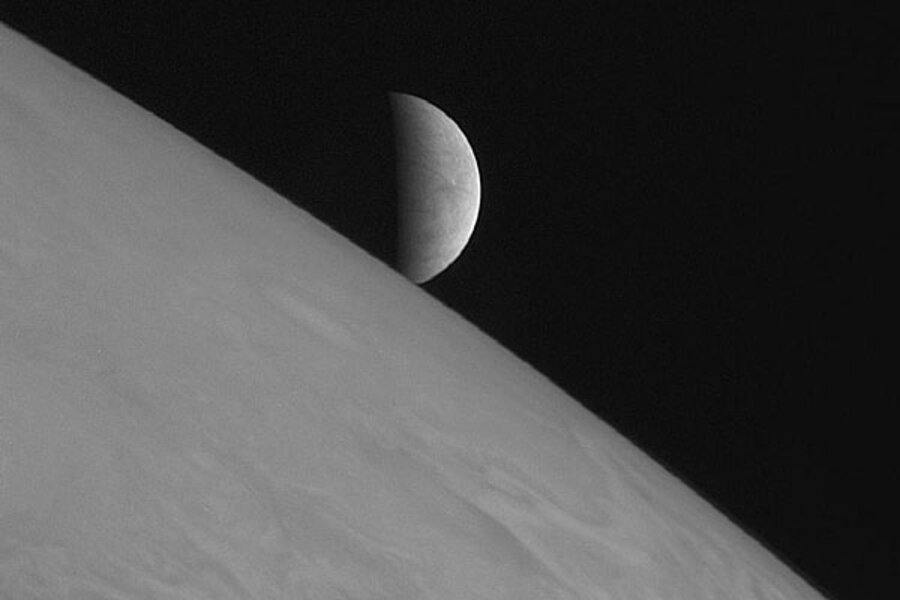A real-life 'Avatar'? Search begins for moons that could support life.
Loading...
How many planets discovered by NASA's Kepler mission might have moons?
That's a question a team of astronomers is trying to answer, and if they find any, what tales those moons might tell.
Distant moons could yield insights into the formation and evolution of planetary systems unlike our own. In addition, they could also host environments hospitable for life, even if the planets they orbit don't.
Finding so-called exomoons is a daunting task. But as Kepler searches for Earth-size planets orbiting at Earth-like distances around sun-like stars, the Hunt for Exomoons with Kepler (HEK) aims to use similar techniques to find a new trove of celestial objects.
Even within our solar system moons may offer the potential for life. Jupiter's moon Europa and Saturn's moon Enceladus, for instance, have piqued interest because evidence indicates they have liquid water – a key ingredient for life – beneath their ice surfaces. Another Saturnian moon, Titan, does not appear habitable but is fascinating in its own right, with rain, lakes, and rivers of liquid hydrocarbons.
Yet these moons fall far outside the sun's habitable zone – the place where, if a planet has a sufficient atmosphere, the amount of starlight it gets is "just right" to allow water to exist as liquid, ice, and gas at or near the surface.
During its search for planets inside their stars’ habitable zones, Kepler could also find evidence of moons worthy of further study.
The HEK team is looking for moons with more heft than any in our solar system – at least 10 percent of Earth's mass. By contrast, the largest moon in the solar system, Jupiter's satellite Ganymede, has about 2.5 percent of Earth's mass.
The project, which began in earnest about four months ago, already has yielded objects the team wants to examine in more detail, according to David Kipping, an astronomer at the Harvard-Smithsonian Center for Astrophysics in Cambridge, Mass.
These objects "were really easy to spot; they just stuck out like sore thumbs," Dr. Kipping says. "We have about four or five top, top candidates which we are looking at very closely."
How you look for an exomoon
But where planet-hunters have experience in identifying a planet's signature, he cautions, the same can't be said for moon hunters. It may be a year or so before the team will know whether or not it has found its first moon.
Kepler finds planets by staring at roughly 150,000 stars simultaneously for subtle changes in brightness when a planet eclipses its sun.
Kipping's team is hunting for moons in much the same way. In principle, a large moon can betray its presence as it eclipses part of the star, or even as it transits its planet as the planet crosses in front of the star.
By analyzing the depth and duration of dimming, researchers can gain clues about the moon's size.
A moon also tugs on its planet. This would show up as slight variations in the timing of the planet's transits, yielding information about the moon's mass.
From mass and size come density, which yields hints about the moon's bulk composition.
In addition, Kipping adds, such information about the moon can be used to make similar estimates about density and composition of the planet it orbits.
But moon-hunting is not for the impatient.
Kipping says it takes about six or seven transits of a planet across its star to detect with any confidence the presence of a candidate moon. If the planet is at an Earth-like distance from its star, that means six or seven years.
Moreover, the researchers must be able to rule out with a fairly high level of confidence the likelihood that what they see is caused by something other than a planet's moon – imposters such as star spots or even the effect of other planets in a candidate-moon's system.
If the team is successful, it will be one more indication that Kepler's usefulness in tackling questions about stars and planetary systems is exceeding initial expectations.
"The amount of secondary science that can be done" using Kepler's data "is amazing," says Allan Schmitt, a member of the HEK project. "We haven't even scratched the surface."
A moon hunt begins
Kipping, who focuses his research on transiting planets and exomoons, says the formal moon-hunting effort emerged out of email exchanges between him and Mr. Schmitt, a retired software engineer who lives in Minnesota.
Last May, Schmitt took up the hunt for extrasolar planets at PlanetHunter.org. It's a citizen-science project that enlists people to help uncover planet-candidates that the Kepler team itself might have missed. The scientific "civilians" do this by evaluating graphs of how a star's light changes with time during a planet's transit.
These so-called light curves are Kepler's bread and butter.
Mr. Schmitt explains that he had been reading Kipping's formal research papers, particularly those related to a computer model the astronomer had developed to predict what an exomoon's light curve might look like.
When Schmitt compared those modeled curves with what he was seeing on PlanetHunters.org, he found what he thought were potential candidates. He forwarded his results to Kipping, and a collaboration was born.
By last September, it was clear that a hunt for moons in Kepler's data was feasible, and the project began in earnest.
Schmitt now makes the first cut at identifying potential candidate-moons for the rest of the team to study in more detail.
The team is scheduled to introduce the project to colleagues at the winter meeting of the American Astronomical Society, which begins Jan. 8 in Austin, Texas.








